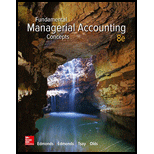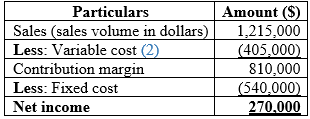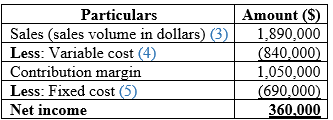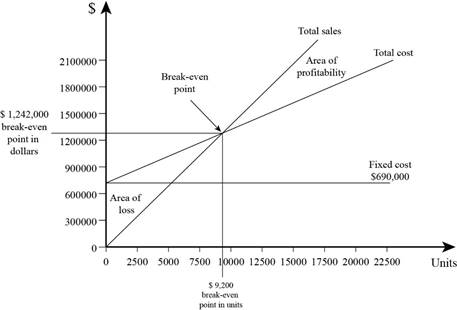
Concept explainers
a.
Calculate the sales volume in units and dollars that is required to earn profit and prepare income statement.
a.
Explanation of Solution
The calculation of sales volume in units is as follows:
Hence, the sales volume in units is 9,000 units.
The calculation of sales volume in dollars is as follows:
Hence, the sales volume in dollars is $1,215,000.
The calculation of income statement is as follows:

(Table 1)
Working note:
The calculation of contribution margin per unit is as follows:
Hence, the contribution margin per unit is $90.
(1)
The calculation of variable cost is as follows:
Hence, the variable cost is $405,000.
(2)
b.
Calculate the income statement and comment whether Company C should whether proceed with the plan.
b.
Explanation of Solution
The calculation of income statement is as follows:

(Table 2)
Company M should continue with the plan to improve the quality of the product. As specified the project should add $90,000 to net income
Note:
The total number of units is 14,000 units
The variable cost is $60
Working note:
The calculation of sales volume in dollars is as follows:
Hence, the sales volume in dollars is $1,890,000.
(3)
The calculation of variable cost is as follows:
Hence, the variable cost is $840,000.
(4)
The calculation of fixed cost is as follows:
Hence, the total fixed cost is $690,000.
(5)
c.
Calculate the margin of safety in dollars, units and as a percentage.
c.
Explanation of Solution
The calculation of break-even points in units is as follows:
Hence, the break-even units is 9,200 units.
The calculation of sales volume in dollars is as follows:
Hence, the sales volume in dollars is $1,242,000.
The calculation of margin of safety in dollars and units is as follows:

(Table 3)
The calculation of margin of safety in percentage is as follows:
Hence, the margin of safety in percentage is 34.29%
Working note:
The calculation of contribution margin per unit is as follows:
Hence, the contribution margin per unit is $75.
(6)
d.
Draw a break-even graph using the data in requirement (c).
d.
Explanation of Solution
The break-even graph is as follows:

Figure 1
Want to see more full solutions like this?
Chapter 3 Solutions
Fundamental Managerial Accounting Concepts
- Sea Harbor, Inc. has a marginal tax rate of 35 percent and an average tax rate of 22 percent. If the firm earns $79,500 in taxable income, how much will it owe in taxes? a. $10,335. b. $16,695. c. $17,490. d. $27,030. e. $27,825.arrow_forwardPlease give me true answer this financial accounting questionarrow_forwardNeed help with this financial accounting questionarrow_forward
- What is the net income percentage ?arrow_forwardCan you please answer the financial accounting question?arrow_forwardidentify the key factors that contributed to the collapse of Northern Rock bank. Compile documents and analysis of regulations (magazine articles, newspapers, online sources, working papers from different organizations, activity summaries, results reports, legal regulations, speeches, public statements, press conferences, etc.). Apply, in a practical and theoretical way, what has been learned in class about the financial world, regulation and risk management.arrow_forward

 AccountingAccountingISBN:9781337272094Author:WARREN, Carl S., Reeve, James M., Duchac, Jonathan E.Publisher:Cengage Learning,
AccountingAccountingISBN:9781337272094Author:WARREN, Carl S., Reeve, James M., Duchac, Jonathan E.Publisher:Cengage Learning, Accounting Information SystemsAccountingISBN:9781337619202Author:Hall, James A.Publisher:Cengage Learning,
Accounting Information SystemsAccountingISBN:9781337619202Author:Hall, James A.Publisher:Cengage Learning, Horngren's Cost Accounting: A Managerial Emphasis...AccountingISBN:9780134475585Author:Srikant M. Datar, Madhav V. RajanPublisher:PEARSON
Horngren's Cost Accounting: A Managerial Emphasis...AccountingISBN:9780134475585Author:Srikant M. Datar, Madhav V. RajanPublisher:PEARSON Intermediate AccountingAccountingISBN:9781259722660Author:J. David Spiceland, Mark W. Nelson, Wayne M ThomasPublisher:McGraw-Hill Education
Intermediate AccountingAccountingISBN:9781259722660Author:J. David Spiceland, Mark W. Nelson, Wayne M ThomasPublisher:McGraw-Hill Education Financial and Managerial AccountingAccountingISBN:9781259726705Author:John J Wild, Ken W. Shaw, Barbara Chiappetta Fundamental Accounting PrinciplesPublisher:McGraw-Hill Education
Financial and Managerial AccountingAccountingISBN:9781259726705Author:John J Wild, Ken W. Shaw, Barbara Chiappetta Fundamental Accounting PrinciplesPublisher:McGraw-Hill Education





